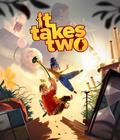Buy It Takes Two
Couch co-op used to be the pinnacle of multiplayer experiences. Spending an afternoon with a friend in a game is among some of my favorite childhood memories. Alas, with the advent of online multiplayer, couch co-op has seen a decline, with few titles offering a fully offline co-op experience. Under Josef Fares, Hazelight Studios has proven that games designed around cooperation can still work and sell well with A Way Out. It offered versatile options to play together either on- or offline, and it also let players invite friends who didn't even own the game. Hazelight's follow-up, It Takes Two, is remarkably similar. While it pushes past A Way Out's achievements in multiple ways, it stumbles when trying to tell a captivating story about family, love, and companionship.
It Takes Two further establishes the very distinct formula that started in A Way Out. Almost the entire game runs in split-screen — even when playing with a friend online — and it bends over backward to introduce new mechanics and environments to keep things fresh. This time we take control of a couple, May and Cody. May has been married to her work for a while, and Cody is raising their daughter Rose. Their relationship has gone awry in recent years, and divorce is pretty much imminent, but Rose has an ace up her sleeve. After acquiring a love handbook, she inadvertently transforms her parents into little dolls, and they'll remain in that form until their relationship is fixed with the help of said handbook.
It's a whimsical start to the adventure that feels like an animated movie. Setup and character designs look and feel like a mix between a Pixar movie and "Honey, I Shrunk the Kids." It never goes beyond that feeling because It Takes Two's Achilles' heel is its narrative and presentation. Cut scenes involving human characters look decidedly rough are aren't well acted or written, and it often felt like an unwelcome distraction from what the title does best: gameplay. Otherwise, narrative segments involving the couple's journey were passable but equally hit-and-miss. Frequent attempts at humor and wit often misfired, and some cut scenes overstayed their welcome. Its story is odd and felt disjointed with characters who evolve and change, but since they start out quite unlikeable, I had a hard time caring about the narrative. That's a shame because the game is an incredible joyride otherwise.
It Takes Two spans nine chapters that should take around 10 hours, depending on one's skill level and thoroughness. Throughout that journey, May and Cody visit several surreal places around their family home and garden, trying to find a way out (pun intended) of their doll bodies while rekindling their love. Stages are distinct from one another. Not only does the locale change drastically between levels, but gameplay mechanics are isolated to a given stage. That means you'll rarely see or do the same things twice throughout the whole journey. That's where It Takes Two shines. While its basic control and move set are similar to a platformer, the game frequently changes skills and genres to keep things fresh: action-RPG, brawler, side-scroller, shooter, and even stealth. It doesn't subscribe to one mood or mechanic; it tries to go where it's fun.
The playable character also makes a difference, since May and Cody have different skills in each stage. Early on, May has a hammer to swing under nails, while Cody can throw nails at walls for May or hold platforms in place. Shortly after, Cody gets a gun that shoots resin, which May can ignite with a gun that shoots matches. I don't want to spoil too many of these, since I was curious to see what abilities we'd get next.
The gameplay in It Takes Two contains quite a bit of serviceable combat, but I found that its collaborative puzzles were especially fun. The issue with puzzles in most games is that they cannot be stretched to the full runtime of a normal game without becoming boring. Since gameplay mechanics change with each level, they are used in clever ways and disappear before they get a chance to feel repetitive. They strike a welcome balance of not being immediately apparent but solvable in a few short minutes. There are some moments when the game gets in a bit of a rut by slowing down too much and presenting several puzzles in a row, but those moments are exceedingly rare.
Combat sections, on the other hand, don't always feel as fresh and fun, but they are serviceable and equally non-repetitive throughout the game. The overall variety is extraordinary, with some abilities close to that of a twin-stick dungeon-crawler and some even manipulate time itself. Level design is equally great, with each stage expanding the scope of the adventure but going hand in hand with the given mechanics so there's always a sense of exploration and adventure. Nothing is laid out in the same manner across the entire runtime. Some stages worked better than others, and a few did not do too much for me, but as a sum of its parts, It Takes Two is impressive from a gameplay and level design standpoint.
Beyond the core gameplay, It Takes Two leaves further room for changes within a level. Minibosses and boss fights are present in pretty much every stage, and each is a highlight. They're mostly large-scale and with multiple phases, requiring you and your gaming companion to work with your distinct skill set to bring them down. They are a logical extension of everything I praised about the level design, and they feel rewarding and fun to figure out without being too complex or overwhelming.
Additionally, the game also features 25 minigames. They're sort of the collectibles in It Takes Two; they're sometimes in plain sight and sometimes hidden behind a corner. These are the only instances where you compete against your co-op partner in fun challenges that could be anything from a snail race to a game of whack-a-mole. Minigames are not essential for progression, and they're infrequent enough to not be overwhelming. They also provide a quick and competitive break to the adventure.
I played through It Takes Two with two different people with vastly different skill sets. First, I played someone who's accustomed to gaming and then one who doesn't usually play games. It Takes Two is forgiving for both audiences. As long as only one of the two characters dies, you can revive yourself by frantically pressing a button. If both die, it's game over, but since the game has a very lenient checkpoint system, that isn't very punishing. The gameplay isn't necessarily a walk in the park, though. If you're a gamer, it'll mostly be a breeze with an occasional death. Essentially, it's the right amount of ease and challenge for a relaxing game.
However, I found that some of the gameplay was relatively challenging for someone without the necessary grip on controlling characters and the camera with two analog sticks. While the game may seem to appeal to a more family-friendly audience and looks like it would be overly welcoming, some parts genuinely became frustrating when playing with someone who's not seasoned in controlling 3D video games. We still had fun, but it seemed at odds with the general vibe and presentation of It Takes Two.
We played It Takes Two on a PS4 Pro, and it was excellent for the most part. Most portions of the game ran at or close to 60fps as far as I could tell, with some more open areas noticeably dropping some frames, but never so much that it interrupted the experience. It runs on a variable resolution, so some portions looked noticeably blurry at times but at the benefit of a mostly smooth frame rate. the game looks pretty, and the attention to detail is captivating in each stage.
Music and sound are very well done, so from an audio-visual standpoint, there isn't much I can bicker about. This extends to the mechanics and gameplay, but the camera can sometimes get in the way and prevent you from seeing threats early enough to react. One additional feature I want to point out is the return of the friend's pass system that was already in place in A Way Out. If you own the game, you can play with a friend, regardless of whether they own the game. It's a welcome and consumer-friendly way of handling and publishing a co-op-only game that I hope will stick around for future releases.
From start to finish, It Takes Two is a great co-op experience. The gameplay is fun and varied throughout the entire run, and it frequently manages to surprise you. It's simply a fun trip to share with a friend, and it's a game that looks like it was as fun to conceptualize as it is to play. That said, the game frequently gets in the way of itself with mediocre and ineffective writing that I found to be fairly forgettable. It's a great game that stops just short of being a masterpiece of co-op gaming. I simply cannot wait to see what Josef Fares comes up with next.
Score: 8.8/10
More articles about It Takes Two










 It Takes Two is co-op adventure where uniquely varied gameplay and emotional storytelling intertwine in a fantastical journey.
It Takes Two is co-op adventure where uniquely varied gameplay and emotional storytelling intertwine in a fantastical journey.





